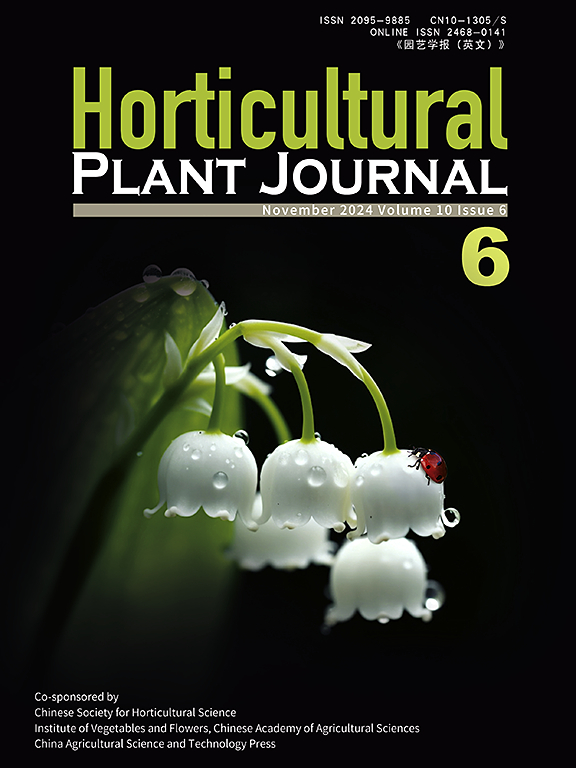土壤熏蒸后,芽孢杆菌激活有益土壤微生物,促进黄瓜的生长和健康
IF 6.2
1区 农林科学
Q1 HORTICULTURE
引用次数: 0
摘要
黄瓜根腐病主要由枯萎菌引起,通过土传感染、血管性枯萎和产量损失威胁着全球黄瓜生产。用氰胺钙(CaCN2)熏蒸土壤可以有效抑制土壤传播的病原体,但可能会损害有益的土壤微生物群。研究了接种velezensis芽孢杆菌(Bacillus velezensis, ZF336)对CaCN2熏蒸后有益土壤微生物活化的增效作用及其对黄瓜根腐病的防治作用。研究了土壤理化性质、微生物群落结构及黄瓜植株的健康状况。结果表明:(1)CaCN2与ZF336联合处理显著提高了土壤的氢电位(pH),有机质(OM)、硝态氮(NO3-N)和铵态氮(NH4-N)含量。(II) CaCN2和ZF336联合处理降低了土壤中镰刀菌的相对丰度,提高了土壤中潜在有益菌木霉和青霉的相对丰度。此外,B. velezensis促进了CaCN2消毒后微生物群落的恢复。(3) CaCN2与ZF336联合处理提高了碳水化合物酶活性,有效促进了土壤碳代谢,提高了纤维素酶、半纤维素酶和木质素的分解能力。综上所述,CaCN2与白僵菌联合施用可刺激土壤微生物群落结构和特定酶活性,是防治黄瓜根腐病、提高产量和土壤质量的有效途径。本文章由计算机程序翻译,如有差异,请以英文原文为准。
Bacillus velezensis activates beneficial soil microorganisms to promote the growth and health of cucumber after soil fumigation
Cucumber root rot, primarily caused by Fusarium solani , threatens global cucumber production through soil-borne infection, vascular wilt, and yield loss. Soil fumigation with Calcium cyanamide (CaCN2 ) effectively suppresses soil-borne pathogens but may impair beneficial soil microbiota. This study investigated the synergistic effects of Bacillus velezensis (ZF336) inoculation on reactivating beneficial soil microbes after CaCN2 fumigation and its role in controlling cucumber root rot caused by F. solani . The physicochemical properties and microbial community structure of the soil and the health of the cucumber plants were investigated. Our findings revealed the following: (I) The potential for hydrogen (pH) and the contents of organic matter (OM), nitrate nitrogen (NO3 –N) and ammonium nitrogen (NH4 –N) significantly increased after combined CaCN2 and ZF336 treatment. (II) Combined CaCN2 and ZF336 treatment reduced the relative abundance of Fusarium and increased the relative abundances of the potentially beneficial bacteria Trichoderma and Penicillium in the soil. In addition, B. velezensis promoted the recovery of microbial communities after CaCN2 disinfection. (III) Combined CaCN2 and ZF336 treatment improved the activities of carbohydrate enzymes, effectively promoting soil carbon metabolism and increasing the cellulase, hemicellulose and lignin decomposition abilities. In conclusion, CaCN2 combined with B. velezensis stimulated the soil microbial community structure and the activities of specific enzymes and is an effective way to control cucumber root rot disease and improve yield and soil quality.
求助全文
通过发布文献求助,成功后即可免费获取论文全文。
去求助
来源期刊

Horticultural Plant Journal
Environmental Science-Ecology
CiteScore
9.60
自引率
14.00%
发文量
293
审稿时长
33 weeks
期刊介绍:
Horticultural Plant Journal (HPJ) is an OPEN ACCESS international journal. HPJ publishes research related to all horticultural plants, including fruits, vegetables, ornamental plants, tea plants, and medicinal plants, etc. The journal covers all aspects of horticultural crop sciences, including germplasm resources, genetics and breeding, tillage and cultivation, physiology and biochemistry, ecology, genomics, biotechnology, plant protection, postharvest processing, etc. Article types include Original research papers, Reviews, and Short communications.
 求助内容:
求助内容: 应助结果提醒方式:
应助结果提醒方式:


